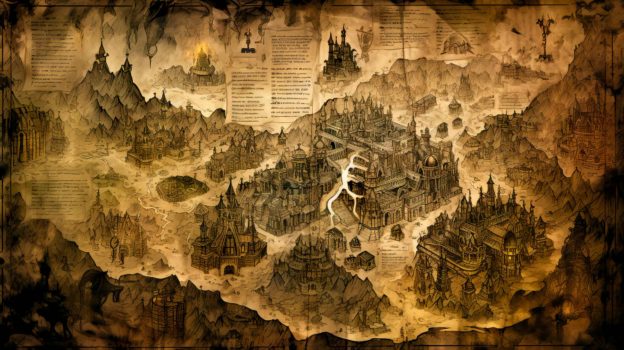 Pin
Pin Image from Freepik
Deep in monastery halls and temple chambers, whispered words carry weight that ordinary language cannot match. These rare ancient sacred languages in the world represent humanity’s oldest attempts to bridge the gap between earthly existence and divine understanding.
Unlike modern tongues shaped by commerce and casual conversation, sacred languages emerged from ritual, prayer, and mystical experience. Each syllable was crafted with intention, every phrase designed to elevate consciousness or invoke spiritual presence. Ancient priests, shamans, and mystics believed certain sounds could literally reshape reality.
Today, scholars estimate fewer than a dozen truly sacred languages survive with active practitioners. Most exist only in fragments—carved into stone temples, preserved in crumbling manuscripts, or passed down through unbroken lineages of dedicated keepers. Yet their influence extends far beyond their dwindling communities, shaping world religions and spiritual practices that billions still follow.
Table of Contents
1. Sanskrit
Sanskrit flows like music through Hindu temples, each syllable vibrating with three thousand years of spiritual refinement. Ancient sages called it “the perfected speech,” believing its sounds naturally aligned human consciousness with cosmic forces. Modern neuroscientists have discovered that chanting Sanskrit actually changes brainwave patterns, creating states similar to deep meditation.
The Vedas, Hinduism’s oldest texts, were composed entirely in Sanskrit and transmitted orally for centuries before anyone dared write them down. Priests memorized thousands of verses with perfect accuracy, understanding that even slight mispronunciation could diminish the mantras’ spiritual power. Today, traditional Brahmin families still teach their children this ancient tongue from infancy.
Beyond India’s borders, Sanskrit influenced Buddhist traditions across Asia. Tibetan monks chant Sanskrit prayers, Japanese temples echo with Sanskrit seed syllables, and yoga practitioners worldwide repeat Sanskrit mantras without fully grasping their profound linguistic heritage. This single language shaped spiritual practice for nearly half the world’s population.
2. Hebrew
Hebrew letters dance across ancient scrolls like architectural blueprints for creation itself. Jewish mystics believe each character contains creative force—the same power God used to speak the universe into existence. The Torah’s opening words, “Bereshit bara Elohim,” don’t just describe creation; they participate in it through the sacred geometry of Hebrew script.
Unlike other ancient languages that evolved naturally, Hebrew allegedly descended directly from heaven. Rabbinical tradition teaches that God gave Moses not just the Ten Commandments, but the entire Hebrew alphabet as divine revelation. Each letter carries numerical value, mystical meaning, and cosmic significance that scholars spend lifetimes unraveling.
After nearly dying out as a spoken language, Hebrew experienced history’s most remarkable linguistic resurrection. Modern Israel revived it for daily use, yet sacred Hebrew remains distinct—reserved for prayer, study, and ritual. Orthodox Jews still debate whether ancient pronunciation has been lost forever, making every synagogue service an attempt to recover heaven’s original voice.
3. Latin
Stone cathedrals still echo with Latin phrases that once unified all of Christian Europe under a single sacred tongue. For over a millennium, Latin Mass connected peasants in Ireland with nobles in Italy, creating a spiritual language that transcended political borders. Priests chanted “Kyrie eleison” and “Gloria in excelsis Deo” in identical rhythms from England to Egypt.
The Catholic Church chose Latin not for convenience, but for permanence. While living languages shift meaning with each generation, Latin remained frozen in sacred time—unchanging, precise, and removed from everyday corruption. Church fathers believed this stability protected divine truth from human tampering. Every theological concept required exact Latin terminology that scholars debated for centuries.
Vatican II’s decision to embrace vernacular languages in 1965 shocked traditionalists who viewed Latin as irreplaceable. Yet Latin persists in papal documents, theological education, and traditional Catholic communities worldwide. Some argue that losing Latin disconnected modern Catholics from fifteen centuries of accumulated spiritual wisdom embedded in those ancient syllables.
4. Aramaic
In dusty Palestinian villages, a handful of families still speak the language that once flowed from Jesus’s lips. Aramaic dominated the ancient Middle East for nearly a thousand years, serving as the region’s diplomatic tongue long before Arabic arrived. When Christ taught the Lord’s Prayer, he spoke Aramaic words like “Abwoon d’bwashmaya”—sounds that carried different emotional weight than their Greek or Latin translations.
Many of Jesus’s most famous sayings lose crucial meaning in translation from their original Aramaic. “Talitha koum,” spoken to raise a dead girl, carries tender intimacy that “Little girl, arise” cannot capture. Aramaic’s poetic structure and cultural context reveal layers of meaning that two millennia of translation have gradually obscured.
Today, fewer than half a million people worldwide understand Aramaic, mostly scattered across Syria, Iraq, and isolated Christian communities. ISIS deliberately targeted Aramaic-speaking villages, viewing their ancient tongue as a threat to Islamic purity. Each elderly speaker who passes away takes irreplaceable linguistic treasures with them, making Aramaic preservation efforts increasingly desperate yet vital.
5. Ancient Egyptian
Golden tomb walls shimmer with hieroglyphs that ancient Egyptians believed possessed literal magic. These sacred symbols weren’t mere writing—they were “words of the gods” that could grant eternal life, protect the dead, and maintain cosmic order. Priests guarded hieroglyphic knowledge jealously, understanding that controlling divine language meant controlling access to the afterlife.
The famous Rosetta Stone unlocked hieroglyphic secrets in 1822, but scholars quickly discovered that sacred Egyptian contained multiple layers of meaning. Religious texts operated simultaneously as historical record, magical spell, and cosmic map. Temple walls weren’t decorated with hieroglyphs—they were activated by them, transforming stone chambers into gateways between worlds.
Modern Coptic Christians preserve fragments of ancient Egyptian in their liturgy, though most worshippers no longer understand the words they chant. Archaeological discoveries continue revealing new hieroglyphic texts, but the living tradition died with the last temple priests fifteen centuries ago. Each translation attempt captures facts while inevitably losing the spiritual resonance that made these symbols sacred.
6. Tibetan
High-altitude winds carry Tibetan prayers across the Himalayas, where colorful flags inscribed with sacred mantras flutter like messages to heaven. Tibetan Buddhism developed unique relationships between written symbols and spiritual power, believing certain texts could liberate souls simply through visual contact. Prayer wheels spin endlessly, each revolution equivalent to reciting thousands of mantras stored within.
The Tibetan language evolved specifically to translate Sanskrit Buddhist concepts, creating precision that other languages couldn’t match. Words like “bardo” (intermediate state) and “tulku” (reincarnate teacher) express complex spiritual realities that require lengthy explanations in English. Tibetan grammar itself reflects Buddhist philosophy, with verb tenses indicating levels of certainty that mirror meditation insights.
China’s occupation scattered Tibetan teachers worldwide, ironically spreading their sacred language beyond its mountain homeland. Western meditation centers now echo with Tibetan chants, while scholars race to preserve manuscripts before political pressure erases them forever. The Dalai Lama’s exile transformed Tibetan from a regional sacred tongue into a global symbol of spiritual resistance and wisdom.
7. Ge'ez
Deep in Ethiopian highlands, Orthodox priests still chant in Ge’ez, a language that died as everyday speech over a thousand years ago yet lives on in sacred ritual. This ancient Semitic tongue carries Christianity’s earliest African traditions, preserving biblical texts and liturgical practices that vanished elsewhere. Ethiopian monks believe their churches house the original Ark of the Covenant, protected by Ge’ez prayers older than Islam.
Ge’ez script flows across hand-illuminated manuscripts like artistic calligraphy, each letter carefully formed by scribes who spent decades mastering their craft. These books contain unique biblical texts, including the complete Book of Enoch that other Christian traditions lost. Ethiopian Christianity developed in isolation, creating religious practices and sacred literature found nowhere else on earth.
Modern Ethiopia faces pressure to modernize its ancient church, yet Ge’ez remains irreplaceable in Orthodox worship. Young priests still memorize countless Ge’ez chants, though few understand their literal meaning. This linguistic preservation represents Africa’s longest continuous Christian tradition, stretching back to the fourth century when most of Europe remained pagan.
8. Avestan
Ancient Persian fire temples once echoed with Avestan hymns that praised light’s victory over darkness. This sacred language preserved the teachings of Zoroaster, whose revolutionary ideas about good versus evil profoundly influenced Judaism, Christianity, and Islam. Zoroastrian priests memorized thousands of Avestan verses with such precision that modern scholars can reconstruct ancient pronunciation from their oral tradition.
The Avesta, Zoroastrianism’s holy book, describes cosmic battles between Ahura Mazda (Wise Lord) and Angra Mainyu (Destructive Spirit) using poetic language that predates most world scriptures. These texts established concepts of heaven, hell, final judgment, and messiah figures that later religions adopted. Avestan prayers accompanied sacred fire rituals that have burned continuously for over two millennia.
Today, fewer than 200,000 Zoroastrians worldwide preserve Avestan through daily prayers and fire ceremonies. Parsi communities in India and Iran maintain this ancient tongue despite facing demographic decline and conversion pressures. Each Zoroastrian funeral includes Avestan chants that guide souls through afterlife realms described in humanity’s oldest monotheistic literature.
9. Classical Arabic
The melodious recitation of Quranic Arabic flows through mosques worldwide, carrying the exact words Muslims believe God spoke to Prophet Muhammad over fourteen centuries ago. This classical form of Arabic differs significantly from modern spoken dialects, preserved in its original seventh-century form to maintain divine authenticity. Islamic tradition holds that the Quran cannot be truly translated—only interpreted—because Allah chose specific Arabic words whose sacred meaning would be lost in any other language.
Arabic calligraphy transforms Quranic verses into visual art, with flowing scripts adorning mosque walls like prayers made visible. Master calligraphers spend decades perfecting letterforms that must balance artistic beauty with religious precision. Each stroke carries spiritual significance, turning written Arabic into meditation practice where form and meaning unite in sacred geometry.
Over 1.8 billion Muslims worldwide memorize Quranic Arabic regardless of their native tongue, creating history’s largest community united by a single sacred language. Children in Indonesia, Nigeria, and Bosnia learn identical pronunciations of verses they may not literally understand but experience as direct divine communication. This linguistic unity across diverse cultures makes Arabic perhaps the most widely preserved sacred language in human history.
10. Church Slavonic
Candlelit Orthodox cathedrals resonate with Church Slavonic hymns that once unified the massive Byzantine spiritual empire from Russia to the Balkans. This ancient liturgical language emerged in the ninth century when Saints Cyril and Methodius created the Cyrillic alphabet specifically to translate Greek scriptures for Slavic peoples. Unlike Latin’s dominance in Western Christianity, Church Slavonic allowed Eastern Orthodox believers to worship in their own linguistic family.
The language froze in sacred time around the eleventh century, preserving medieval Slavic vocabulary and grammar that modern Russian, Bulgarian, and Serbian speakers find beautifully archaic yet mysteriously familiar. Orthodox priests chant prayers using verb forms and religious terminology that disappeared from everyday speech centuries ago, creating an otherworldly atmosphere during Divine Liturgy.
From Moscow’s golden domes to Mount Athos monasteries, Church Slavonic maintains Orthodox unity across national boundaries. Russian, Greek, Serbian, and Romanian Orthodox communities all incorporate Slavonic elements in their worship, though each tradition adds local linguistic flavors. This sacred tongue survived Communist persecution, Nazi occupation, and modern secularization—proving that spiritual languages possess remarkable resilience when communities refuse to let them die.
The Eternal Echo of Sacred Words
These ancient tongues refuse to die because they carry something ordinary language cannot—the accumulated spiritual weight of countless generations who believed words could touch the divine. Modern believers still experience unexplainable peace when hearing Sanskrit mantras, Latin masses, or Tibetan chants, suggesting these languages tap into profound psychological or spiritual realities that science barely understands.
Technology now preserves sacred languages that oral tradition maintained for millennia. Digital archives store pronunciation guides, while smartphone apps teach ancient scripts to new generations. Yet scholars worry that recording these languages might actually accelerate their death—transforming living spiritual practices into museum artifacts studied rather than experienced.
The survival of sacred languages depends entirely on communities willing to dedicate their lives to preservation. Each child who learns Hebrew prayers, each monk who chants in Tibetan, each priest who studies Latin becomes a living library carrying humanity’s oldest spiritual wisdom. Their voices connect us to ancestors who believed certain sounds could literally change reality—a faith that perhaps deserves more consideration than modern skepticism typically allows.
FAQs
While there’s no scientific proof of “magical” abilities, practitioners report deeper meditation states, enhanced focus, and profound spiritual experiences when chanting in ancient tongues like Sanskrit or Hebrew! 🧘♂️✨
Latin offers the best starting point! With familiar alphabet, extensive online resources, and no living speakers to judge your pronunciation, it’s perfect for sacred language newcomers. Plus, it unlocks Catholic mysticism! 📚⛪
Absolutely not! Scholars, linguists, and curious minds study sacred languages for historical, cultural, and academic reasons. Many find unexpected spiritual insights along the way, regardless of personal beliefs! 🤔💭
Several teeter on the edge! Ancient Egyptian hieroglyphs died out completely, while Aramaic survives in tiny pockets. Ge’ez and Avestan exist only in religious contexts. Time is running out for many! ⏰💔
Yes! Neuroscience confirms that chanting Sanskrit mantras, Tibetan prayers, and Hebrew psalms measurably alters brainwave patterns, creating states similar to deep meditation. Ancient wisdom meets modern science! 🧠🔬






























